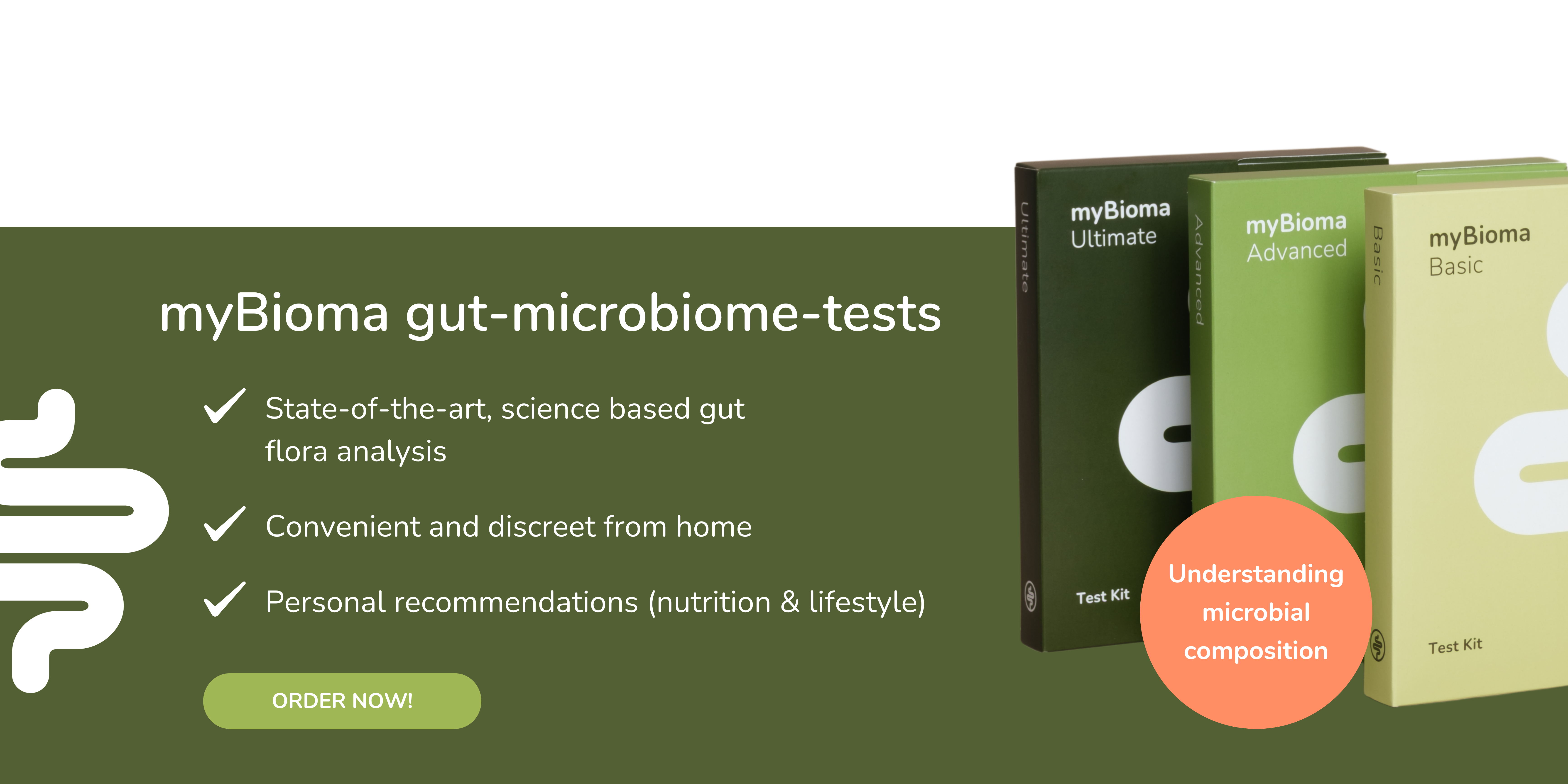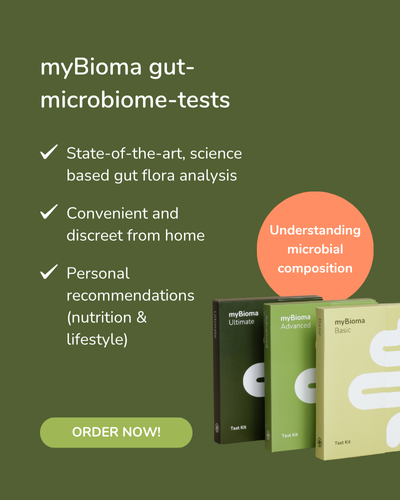Have you always wanted to know which bacteria in the intestinal flora are good or bad? Then you've come to the right place! Today we'll show you 10 bacteria that promote your gut health and how they achieve this. In Part II next week, we'll show you 10 of the little roommates that can be a danger to you. We'll also explain why you don't need to be afraid of bacteria.
The microbiome comprises all the bacteria, fungi, viruses and primordial bacteria and their genetic information that are present in your gut. That's an incredible number of microorganisms. Most of them are bacteria. That is why science is most concerned with them. In our latitudes, we have developed a real bacterial phobia and are afraid of dirt, diseases and germs. However, these fears are unfounded because only 1% of all bacteria cause illness. In fact, without bacteria we would not be able to live the way we are used to. Bacteria are an integral part of our world and we need them to stay healthy. Find out more here!
We enter into so-called symbioses with many bacteria in the intestine, i.e. we help each other, for example by providing food and the bacteria care for the intestinal mucosa.
However, bacteria are not dear friends who only want to help us.They are small organisms that simply try to survive.This means that bacteria behave differently depending on their environment. If the intestine is chronically inflamed, an otherwise peaceful bacterium may react more harmfully than in a healthy intestine. It is therefore important to recognize that bacteria contribute to our health, but are neither our friends nor our enemies.(1)
Furthermore, the microbiome is not just about individual bacteria, but the totality of all bacteria has an effect on health (1).Many studies have discovered particularly helpful bacteria in the gut flora - let's take a look at them now!
1. Faecalibacterium prausnitzii
F. prausnitzii is a bacterium that has been recognized in many studies as having anti-inflammatory and health-promoting properties.It has been associated with a reduced risk of obesity and many diseases such as diabetes and lipometabolic disorders.In inflammatory bowel disease, the bacterium is often absent and may be involved in the complex disease. F. prausnitzii also supports the intestinal mucosa in its regeneration: by breaking down dietary fiber, it produces short-chain fatty acids that nourish the mucosa.(2, 3)
2. Lactobacillus
Lactobacilli, also known as lactic acid bacteria, are the bacteria that turn milk into yoghurt or cheese. During fermentation, the lactobacilli digest the lactose and leave behind lactic acid as "waste". This gives yogurt its sour taste. Lactobacilli are also often used as probiotics because they support the immune system and can alleviate complaints such as diarrhea or constipation (4, 5). You can also do something good for your gut by eating foods rich in lactobacilli, such as sourdough bread, sauerkraut or olives. (6)

Lactic acid bacteria are masters of fermentation - this is how they convert milk into yogurt.
3. Roseburia hominis
The influence of the Roseburia group of bacteria on the body has not yet been fully researched. Some studies find a health-promoting influence, others show the opposite. This is probably due to the fact that there are different types of Roseburia. The bacterium R. hominis is the best researched. In people with ulcerative colitis, an inflammatory bowel disease, R. hominis is absent and could be tested as a treatment in the future. (7)
4. Akkermansia muciniphila
A. muciniphila is an extremely exciting bacterium. It has already been investigated in many studies and appears to be present in reduced amounts in the intestine in some diseases. It may protect against obesity, chronic inflammation and diabetes. Even in multiple sclerosis, a nerve disease, the bacterium is greatly reduced and its absence could contribute to the disease. (2, 8)
5. Bifidumbacterium
The Bifidobacterium group of bacteria are also lactic acid bacteria and can break down lactose during fermentation. They are mainly found in dairy products such as yogurt or kefir. Here we show you how you can easily make your own yogurt! Some studies have shown that the presence of bifidobacteria is reduced in overweight people. They could therefore possibly contribute to a normal weight (9). Like lactobacilli, bifidobacteria are often used in probiotics - i.e. in the form of tablets or powder to supplement the intestinal flora. If you'd like to learn more about bifidobacteria, be sure to check out this blog post: Bifidobacteria: How they improve our health and digestion

Probiotics contain health-promoting bacteria and are intended to supplement the intestinal flora.
6. Methanobrevibacter smithii
Methanobrevibacter are something very special: they are not bacteria, but belong to the so-called archaea or primordial bacteria. Archaea are similar to bacteria, but are a separate life form. Methanobrevibacter also lives in the intestine and is part of the microbiome. In one study, M. smithii was associated with healthy body weight and thus protected against obesity.
The metabolism of M. smithii produces methane gases in the intestine, which can lead to flatulence and abdominal pain. This primordial bacterium could therefore also be involved in the symptoms of irritable bowel syndrome. (9, 10)
7. Alistipes
We return to the bacteria: the Alistipes group of bacteria also belongs to the group of bacteria that have an anti-inflammatory and protective effect in the intestine. Alistipes is reduced in Crohn's disease, a chronic inflammatory bowel disease. It also appears to protect against obesity and diabetes. (11)
8. Prevotella
The group of Prevotella bacteria is extremely interesting. Based on the most frequently occurring bacteria in the intestine, each person can be assigned to one of three "enterotypes". The enterotype is therefore named depending on the dominant bacteria and is strongly influenced by the diet. Prevotella forms one of these enterotypes and is mainly found in people with a plant-based diet, which is considered one of the healthiest forms of nutrition. On the other hand, Prevotella has also been associated with inflammatory diseases in some studies and could possibly be harmful to the gut. The study situation is therefore not yet sufficiently clear What is clear is that Prevotella definitely plays a major role in our gut! (12, 13)

Bacteria such as enterococci are needed to produce the tastiest cheeses.
9. Enterococcus
Although the name does not suggest it, enterococci, also known as enterococci, also belong to the lactic acid bacteria. They are not only used as probiotics, but also in the production of certain foods such as mozzarella, camembert and goat's cheese (delicious). In the body, their benefits depend on the exact Enterococcus species. Most enterococci are normal intestinal inhabitants. For example, they produce anti-inflammatory substances. However, other enterococcus species can be pathogenic. (6, 14, 15)
10. Lactococcus
Lactococcus belongs to the lactic acid bacteria and is mainly found in dairy products such as buttermilk, kefir and cheese. Lactococci are also often used as probiotics to supplement the intestinal flora. Lactococci produce anti-inflammatory substances and at the same time strengthen the immunity of your intestinal mucosa. (16)
This is a small selection of all the gut bacteria that can have a positive effect on your body and your health, but don't forget that it always depends on the combination of all bacteria and that just one single bacterium cannot make your gut healthy!
References
- Bäckhed F, Fraser CM, Ringel Y, et al. Cell Host Microbe, 2012;12(5):611-22.
- Le chatelier E, Nielsen T, Qin J, et al. Nature, 2013;500(7464):541-6.
- Quévrain E, Maubert MA, Michon C, et al. Gut, 2016;65(3):415-425.
- Harsharn Gill, Jaya Prasad, Advances in Experimental Medicine and Biology, vol 606. Springer, New York, NY, 2008, ISBN 978-0-387-74087-4, S 423-454.
- Nagendra P Shah, International Dairy Journal, 2007;17(11):1262-1277.
- Hans G. Schlegel, Christiane Zaborosch: Allgemeine Mikrobiologie. 7. Auflage. Thieme Verlag, Stuttgart/New York 1992, ISBN 3-13-444607-3, S. 100 f., 296–304.
- Machiels K, Joossens M, Sabino J, et al. Gut. 2014;63(8):1275-83.
- Jangi S, Gandhi R, Cox LM, et al. Nature Communication 2016;7:12015.
- Million, M. et al. International Journal of Obesity 2011;36(817).
- Weaver, G., Krause, J., Miller, T. & Wolin, M. Gut, 1986;27(698).
- Willing BP, Dicksved J, Halfvarson J, et al. Gastroenterology, 2010;139(6):1844-1854.e1.
- Ley RE. Nature Rev Gastroenterology & Hepatology, 2016;13(2):69-70.
- Arumugam, M. et al. Nature, 2011;473(174).
- Ouwehand AC, Forssten S, Hibberd AA, et al. Annals of Medicine, 2016;48:4, 246-255.
- Fouliquie Moreno MR, Sarantinopoulos P, Tsakalidou E, et al. International Journal of Food Microbiology, 2006;106(1):1-24.
- Holzapfel WH, Haberer P, Geisen R, et al. American Journal of Clinical Nutrition, 2001;73(2):365S–373.







